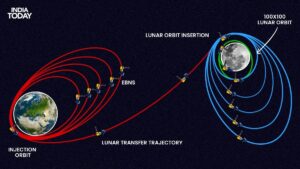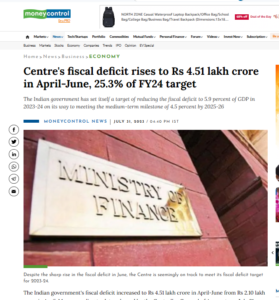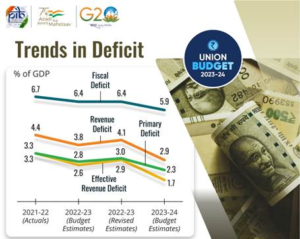Topics
- Global Tobacco Epidemic
- Double-Nuclei Galaxies
- PM-Kusum
- Fiscal Deficit
- National Action for Mechanized Sanitation Ecosystem (NAMASTE)
- TransLunar Injection (TLI)
Global Tobacco Epidemic
Introduction
- The World Health Organization (WHO) has recently reported that both the Netherlands and Mauritius have taken significant steps in implementing all recommended measures to reduce tobacco smoking globally.
- These efforts align with the WHO’s ongoing mission to combat the global tobacco epidemic and protect people from the harmful effects of tobacco smoke.
The MPOWER Tobacco Control Measures
The WHO’s MPOWER tobacco control measures serve as a comprehensive guide for countries looking to combat tobacco use effectively. These measures encompass various aspects, including:
- Monitor Tobacco Use and Prevention Policies: Countries are encouraged to closely monitor tobacco use trends and the effectiveness of their prevention policies. This data-driven approach helps them refine their strategies and make informed decisions.
- Protect People from Tobacco Smoke: Ensuring smoke-free environments is vital to safeguard public health. Measures should focus on preventing passive smoking and reducing exposure to second-hand smoke.
- Offer Help to Quit Smoking: Countries must provide support and resources to help individuals quit smoking. This includes access to counseling, treatment, and cessation programs.
- Warn About the Dangers of Tobacco: Raising awareness about the risks associated with tobacco consumption is crucial. Countries should implement effective warning labels and educational campaigns.
- Enforce Bans on Tobacco Advertising, Promotion, and Sponsorship: Strict regulations on tobacco advertising, promotion, and sponsorship are essential to prevent the tobacco industry from enticing new users.
- Raise Taxes on Tobacco: Implementing higher taxes on tobacco products not only reduces consumption but also generates revenue that can be used for tobacco control initiatives.
Global Progress and Challenges
- The WHO’s efforts, along with the commitments made by Parties of the WHO Framework Convention, have contributed to a decline in the global prevalence of smoking.
- From 22.8 percent in 2007, the smoking rate has decreased to 17 percent in 2021.
- However, tobacco smoking remains the leading cause of preventable death, responsible for the loss of 8.7 million lives annually, including 1.3 million from exposure to second-hand smoke.
Call for Action
- Despite progress, there are still challenges to overcome. Currently, 74 countries lack adequate regulations addressing tobacco products, including bans on smoking in public places, labeling requirements, and advertising bans.
- To effectively combat the global tobacco epidemic, the WHO urges all nations to scale up their efforts and fully commit to implementing the MPOWER tobacco control measures.
Conclusion
- The joint efforts of the Netherlands and Mauritius, alongside Brazil and Turkey, exemplify the global commitment to reducing tobacco smoking and protecting public health.
- By implementing the WHO’s MPOWER tobacco control measures, countries can make significant strides in preventing tobacco-related deaths and achieving a smoke-free world.
Double-Nuclei Galaxies

Context
- Researchers have recently developed an innovative algorithm that has enabled the identification of thousands of double-nuclei galaxies.
- Among these, a total of 159 galaxies were confirmed to contain pairs of accreting supermassive black holes or active galactic nuclei (AGN).
Understanding Supermassive Black Holes (SMBHs) and AGN
- Supermassive black holes are extremely massive, with masses ranging from a million to several billion times that of the sun.
- Accreting SMBHs, also known as AGN, emit vast amounts of radiation across the electromagnetic spectrum.
- Detecting this radiation is crucial for observing SMBHs in distant galaxies effectively.
Importance of Dual AGN Detection
- Detecting AGN pairs in double-nuclei galaxies is a crucial way of tracing the mergers of massive black holes.
- However, the presence of galaxies with double-nuclei and dual AGN is exceptionally rare.
- In the past, fewer than 50 dual AGN were known, often discovered by accident.
Unraveling the Formation of Supermassive Black Holes
- Over time, AGN pairs lead to two supermassive black holes orbiting each other, eventually emitting nano-Hz gravitational waves.
- The final merger of these SMBHs produces a burst of gravitational waves.
Implications for Understanding Galactic Mergers
- Many double-nuclei galaxies have separations similar to that of the Milky Way and Andromeda galaxies.
- These galaxies offer valuable insights into how merging galaxies evolve over time and how their SMBHs appear before eventually merging to form even more massive black holes.
Predicting the Future of the Milky Way and Andromeda
- Studying a substantial sample of double-nuclei galaxies can help predict the future appearance of the Milky Way and Andromeda as they merge.
- This research also suggests that galactic collisions can signal the “beginning of the end” for individual AGN, as they merge to form more massive SMBHs.
Observing Characteristics of Merging Galaxies

- The investigation also revealed that merging galaxies tend to appear red, indicating the presence of old stars and a reduced formation of new stars.
- Red galaxies represent the old, evolved population of galaxies, showing how AGN can suppress star formation, leading to the formation of red and “dead” elliptical galaxies.
PM-Kusum

PM-Kusum stands for Pradhan Mantri Kisan Urja Suraksha evam Utthaan Mahabhiyan. It is a scheme launched by the Government of India in 2019 to provide energy security for farmers in India and to increase the share of renewable energy in the country’s power mix.
Components of PM-Kusum
The scheme has three components:
- Component-A: Setting up of 10,000 MW of decentralized grid connected renewable energy power plants on barren land.
- Component-B: Installation of 17.50 lakh stand-alone solar agriculture pumps.
- Component-C: Solarisation of 10 lakh grid connected agriculture pumps.
| Component | Capacity | Beneficiaries | Tariff | Incentives |
| A | 500 kW to 2 MW | Farmers/ cooperatives/ panchayats/ FPOs/ WUAs | Feed-in-tariff determined by SERCs | Procurement Based Incentive of Rs. 0.40 per unit or Rs. 6.6 lakh per MW per year for 5 years |
| B | Up to 7.5 HP | Individual farmers in off-grid areas | N/A | Central Financial Assistance of 30% of the benchmark or tender cost, State Government subsidy of 30%, Farmer’s contribution of 40% |
| C | Up to 7.5 HP | Individual farmers with grid connected pumps | Pre-fixed tariff for excess solar power sold to DISCOMs | Central Financial Assistance of 30% of the benchmark or tender cost, State Government subsidy of 30%, Farmer’s contribution of 40% |
Objectives and Benefits of PM-Kusum
- To provide energy security and income support to farmers.
- To reduce dependence on diesel and grid power for irrigation.
- To promote decentralized and distributed renewable energy generation.
- To contribute to India’s Intended Nationally Determined Contributions (INDCs) of increasing the share of non-fossil-fuel sources to 40% by 2030.
The expected benefits of the scheme are:
- Saving of about 27 million tonnes of CO2 emission per annum.
- Saving of about Rs. 50,000 crore per annum on diesel import.
- Creation of local employment and entrepreneurship opportunities.
- Improvement in quality and reliability of power supply in rural areas.
Implementation and Status of PM-Kusum
- The scheme is being implemented by the Ministry of New and Renewable Energy (MNRE) through various State Nodal Agencies (SNAs) and State Implementing Agencies (SIAs).
- As per the latest data available on the MNRE website, as on November 30, 2021, the following progress has been made under the scheme:
- Under Component-A, out of the target capacity of 10,000 MW, bids have been received for 3,390 MW and projects have been sanctioned for 3,109 MW.
- Under Component-B, out of the target capacity of 17.50 lakh pumps, bids have been received for 8.63 lakh pumps and projects have been sanctioned for 7.94 lakh pumps.
- Under Component-C, out of the target capacity of 10 lakh pumps, bids have been received for 4.58 lakh pumps and projects have been sanctioned for 4.32 lakh pumps.
National Action for Mechanized Sanitation Ecosystem (NAMASTE)
Intro:
- NAMASTE is a scheme of the government of India that aims to provide safety and dignity to sanitation workers.
- It is a joint initiative of the Ministry of Social Justice and Empowerment, the Ministry of Housing and Urban Affairs, and the Department of Drinking Water and Sanitation.
- The scheme promotes the mechanisation of septic tanks and sewers and provides safety gears, machines, skilled-wage opportunities, and capacity building to the workers.
Components of NAMASTE
The scheme has four components:
- Enumeration: Identifying the sewer/septic tank workers (SSWs) with a focus on the informal workforce who are engaged in hazardous cleaning operations.
- Collectivization: Forming self-help groups (SHGs) of SSWs and empowering them to run sanitation enterprises.
- Skill Building: Providing training and certification to SSWs on safe sanitation practices, machine operation, maintenance, and entrepreneurship.
- Access to Safety Gear and Machines: Providing SSWs with personal protective equipment (PPE), mechanized equipment, and vehicles for safe transportation and disposal of faecal sludge.
Objectives and Benefits of NAMASTE
The main objectives of the scheme are:
- To ensure zero fatalities in sanitation work in India.
- To prevent direct contact of SSWs with human faecal matter.
- To provide SSWs with alternative livelihoods support and entitlements.
- To create awareness among citizens and institutions to seek services from registered and skilled SSWs.
The expected benefits of the scheme are:
- Saving lives and improving health outcomes of SSWs.
- Enhancing income and social status of SSWs.
- Promoting sustainable sanitation services and environmental protection.
- Contributing to the Swachh Bharat Mission 2.0 and Jal Jeevan Mission goals.
Implementation and Status of NAMASTE
- The scheme is being implemented by the National Safai Karamcharis Finance & Development Corporation (NSKFDC) under the Ministry of Social Justice and Empowerment through various State Nodal Agencies (SNAs) and City Namaste Management Units (CNMUs)
- The scheme covers 500 cities across India, converging with AMRUT cities. The cities are selected based on population, capital status, hill/island/tourist destination status, and availability of notified municipalities.
- The scheme has been approved for four years from 2022-23 to 2025-26 with a total budget allocation of Rs. 1,500 crores.
https://pib.gov.in/PressReleasePage.aspx?PRID=1852627
TransLunar Injection (TLI)

Definition: A propulsive maneuver used to set a spacecraft on a trajectory that will cause it to arrive at the Moon.
Purpose: To enable spacecraft to escape Earth’s gravitational pull and travel to the Moon.
Procedure:
– The TLI is performed when the spacecraft is at a specific point in its orbit known as the ‘perigee’ or the closest point to Earth.
– The spacecraft’s propulsion system fires its engines to accelerate the spacecraft.
– The spacecraft gains enough speed to break free from Earth’s gravitational pull and embark on its journey toward the moon.
– The amount of thrust and duration of the TLI burn depends on various factors, including the spacecraft’s mass, its velocity in Earth’s orbit, and the specific mission objectives.
Outcome:
– Once the TLI is successfully completed, the spacecraft is put on a lunar trajectory, and it will continue its journey to the Moon without further propulsion from Earth.
– After the TLI, the spacecraft typically enters a transfer orbit, which is an elliptical path that intersects with the Moon’s orbit.
– The spacecraft continues to travel in its highly eccentric orbit until it reaches the Moon’s surface.
– As the spacecraft approaches the Moon, it may perform additional maneuvers, such as lunar orbit insertion (LOI), to enter into lunar orbit or land on the lunar surface, depending on the mission’s goals.
Examples:
- The first space probe to attempt TLI was the Soviet Union’s Luna 1 on January 2, 1959 which was designed to impact the Moon. The burn however didn’t go exactly as planned and the spacecraft missed the Moon by more than three times its radius and was sent into a heliocentric orbit.
- The first human-crewed mission to perform TLI was Apollo 8 on December 21, 1968, making its crew the first humans to leave low earth orbit.
- 2023 India’s Chandrayaan-3 spacecraft successfully entered lunar orbit after performing TLI on August 1. The spacecraft was launched on July 14 and underwent a series of burns to raise its orbit.
Source: ISRO successfully performs TransLunar Injection; Chandrayaan-3 heads to the moon. https://www.zeebiz.com/india/video-gallery-isro-successfully-performs-translunar-injection-chandrayaan-3-heads-to-the-moon-247018.
Fiscal Deficit

What?
Fiscal deficit is the difference between the total expenditure and revenue of the government. It indicates the amount of borrowing that the government needs to finance its spending.
A high fiscal deficit can have adverse effects on the economy, such as inflation, crowding out of private investment, higher interest rates and external vulnerability.
Latest Data
According to the latest data from the Controller General of Accounts (CGA), India’s fiscal deficit in the first quarter (April-June) of 2023-24 was Rs 4.51 lakh crore, which is 25.3% of the full-year target of Rs 17.86 lakh crore. The fiscal deficit in the same period of 2022-23 was 21.2% of the full-year target.
The main reasons for the widening of the fiscal deficit are:
- A surge in capital expenditure by 59% year-on-year (y-o-y) to boost infrastructure and growth.
- A muted growth in tax revenue by 18.6% y-o-y, which is lower than the budget estimate of 22.9%.
- An increase in net outgo of investment income by 36.7% y-o-y due to higher interest payments and dividends.
Table for the key components of India’s fiscal deficit
| Component | Amount (Rs crore) | |
| Revenue Receipts | 5,98,640 | |
| Tax Revenue (Net) | 4,33,620 | |
| Non-Tax Revenue | 1,65,020 | |
| Revenue Expenditure | 7,72,050 | |
| Capital Expenditure | 2,77,980 | |
| Total Expenditure | 10,50,030 | |
| Fiscal Deficit | -4,51,370 |
Trends and Concerns


